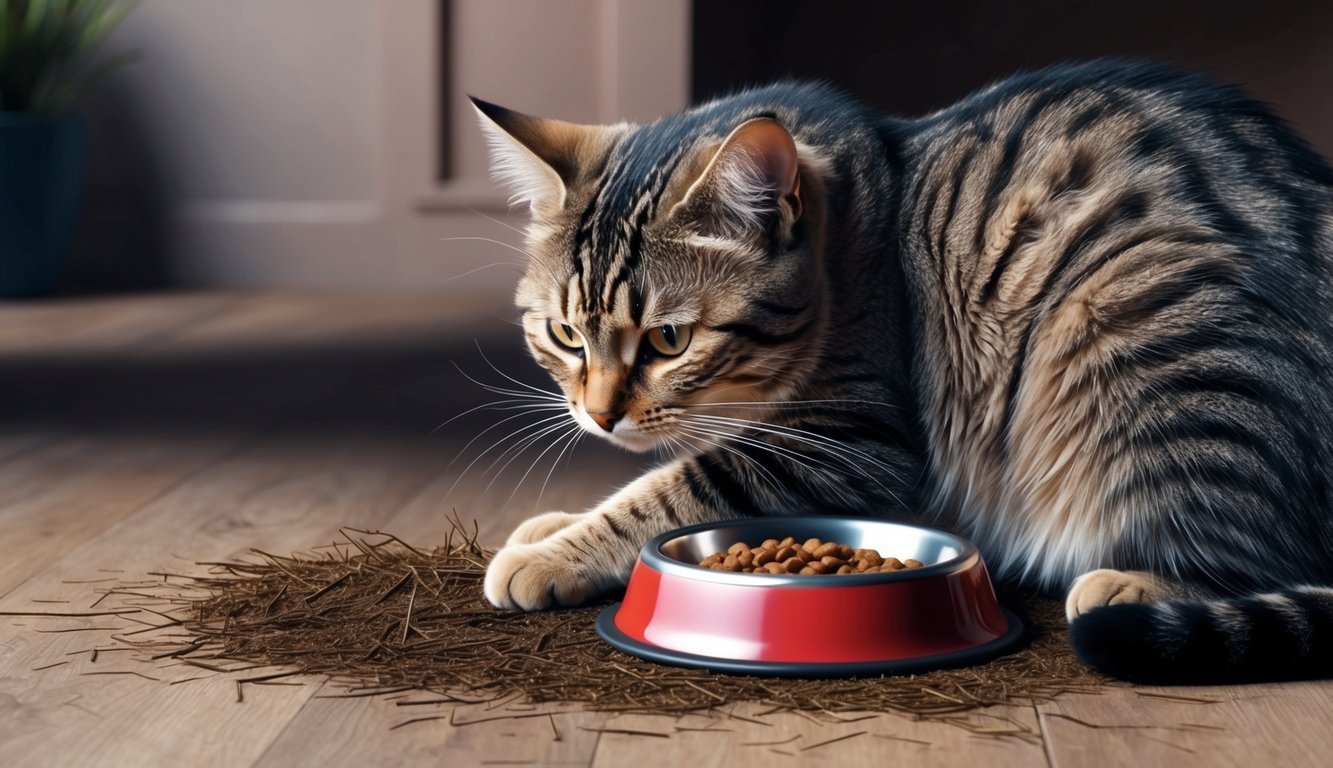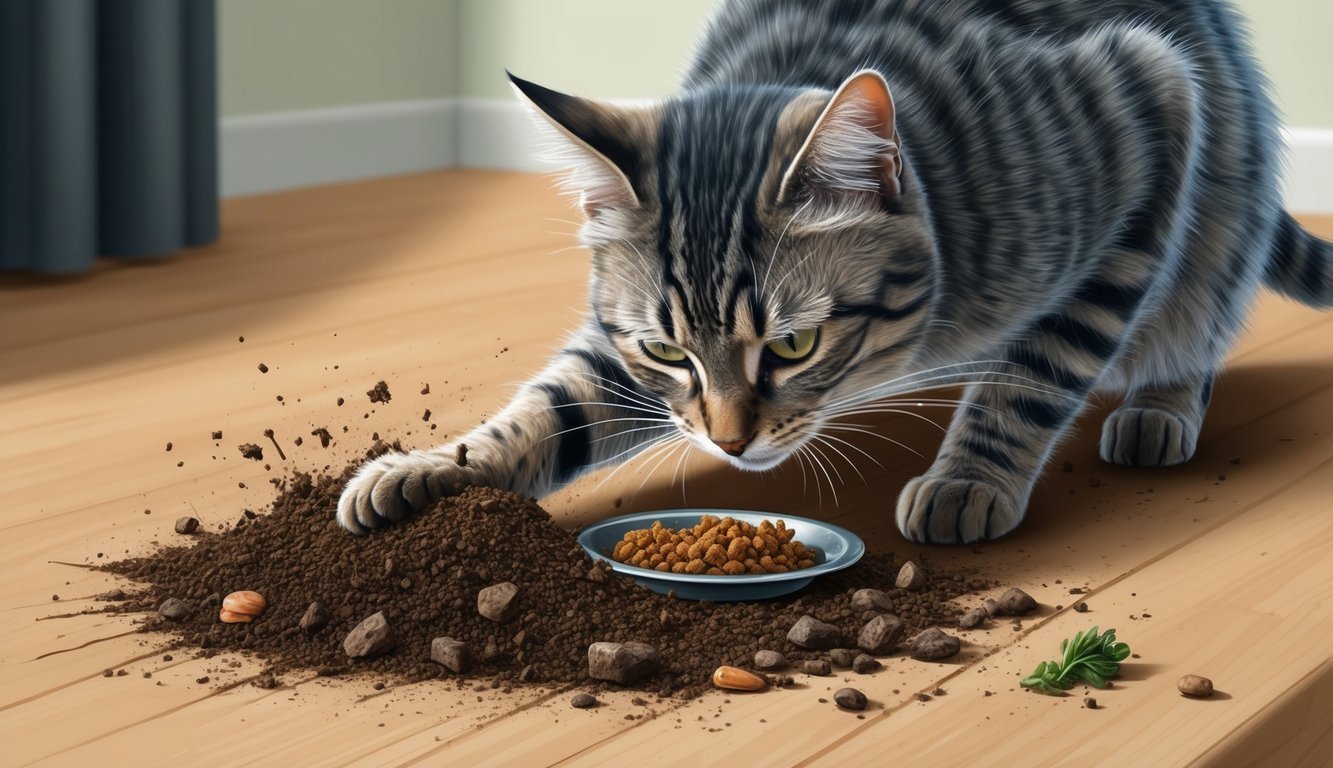Cats exhibit various behaviors that can leave you scratching your head.
One reason your cat might scratch around their food is due to instinctual behavior aimed at hiding leftovers or territory marking.
This scratching can seem odd, but it’s rooted in their instincts and can be linked to their natural hunting and foraging skills.
When a cat scratches the ground around their bowl, they may be mimicking actions taken by their wild ancestors.
This behavior serves multiple purposes, including the instinct to cover or stash food, as well as marking their territory with scent glands located in their paws.
This scratching can seem odd, but it’s rooted in their instincts and can be linked to their natural hunting and foraging skills.
When a cat scratches the ground around their bowl, they may be mimicking actions taken by their wild ancestors.
This behavior serves multiple purposes, including the instinct to cover or stash food, as well as marking their territory with scent glands located in their paws.
Key Takeaways
- Scratching around food is instinctual behavior linked to territory marking.
- This behavior can indicate your cat’s natural hunting instincts.
- Understanding feline behaviors can improve your interaction with your pet.
Understanding Feline Behavior
Cats display a variety of behaviors that can often be puzzling.
Scratching around their food is one such action that stems from their natural instincts and communication methods.
Scratching as Natural Behavior for Cats
Scratching is an instinctive behavior deeply rooted in feline nature.
In the wild, cats scratch before eating to cover their food and mark their territory.
This is a way to communicate their presence to other animals.
When your cat scratches around their food bowl, it may be trying to mimic this natural behavior.
You might notice this especially if your cat seems anxious or if there have been changes in its environment.
This is not just habit; it’s about asserting dominance and ensuring their place in the food chain.
Providing a consistent feeding area can help alleviate some of this instinctual behavior.
The Role of Scent Glands in Feline Communication
Cats have scent glands located in their paws, which play a crucial role in how they communicate.
When a cat scratches, it releases pheromones that convey information to other cats.
These scent markers help establish territory and indicate status.
So, when your cat scratches around its food bowl, it might be a message to other pets in the household.
Your cat’s sense of smell is significantly stronger than yours, which is why these pheromones are a vital part of their social interactions.
Understanding this helps you appreciate the complexity of your cat’s actions.
The Instinct of Scratching Around Food
When your cat scratches around their food, it’s often tied to instinctual behaviors rooted in their wild ancestry.
Understanding these behaviors can help you appreciate why your feline friend exhibits this particular action.
Food Caching: A Survival Tactic
Cats have evolved from wild ancestors that developed various survival tactics.
One key behavior is food caching, where they instinctively scratch and dig to hide leftover food.
In the wild, this behavior helps to conceal food from competitors and potential threats.
By scratching around their meal, they mimic actions of covering up food, which secures it for later consumption.
This instinctual action is still present in domestic cats.
Even if they don’t need to stash their food, you might notice them displaying this behavior.
It’s simply a throwback to their survival skills.
Feeding Habits and Behaviors
When it comes to your cat’s feeding habits, understanding their behaviors can provide insights into their health and well-being.
Cats possess natural instincts that influence how they interact with food, including their scratching behaviors.
Identifying Overfeeding
To determine if you’re overfeeding your domestic cat, observe their body condition and eating habits.
A cat that is consistently overweight may be consuming more than their ideal caloric needs.
Use a scale to weigh your cat regularly.
Signs of Overfeeding:
- Weight Gain: Noticeable increase in body weight or difficulty feeling ribs.
- Increased Scratching: Some cats scratch excessively when discontent with meal portions, leading to potential food aversion.
Adjust their portions based on their activity level and consult with your veterinarian for tailored recommendations.
Keeping a feeding schedule can help regulate their intake.
How Scratching Behavior Relates to Feeding
Scratching around food is a common instinctual behavior for cats.
It can be a way to create a “safe” area around their food.
This instinct dates back to their wild ancestors, who would scratch to hide food from potential threats.
Factors Influencing Scratching:
- Instinctual Behavior: Some cats scratch to mark territory, adding a familiar scent to their feeding area.
- Stress or Anxiety: Changes in environment or routine may trigger increased scratching.
Monitor your cat’s scratching to see if it correlates with stressors or changes in diet.
Addressing these factors can improve your cat’s comfort and reduce excessive scratching around their food.
Kneading and Scratching: Related Instincts?

Kneading and scratching are instinctual behaviors in cats linked to comfort and territory.
Understanding these actions can provide insights into your cat’s feelings and needs.
The Comfort Factor of Kneading
When your cat kneads, it replicates a behavior learned as a kitten.
Kneading against their mother stimulates milk flow, creating a sense of security.
This act often signifies a happy, relaxed cat.
In contrast, scratching around the food bowl may show a different instinct.
It could be an action rooted in the desire to bury leftovers or mask scents.
Both behaviors serve as forms of expression, reflecting your cat’s comfort levels.
Recognizing these actions’ significance can help you better understand your cat’s needs and feelings in their environment.
Frequently Asked Questions
When it comes to cats and their food, scratching behaviors can be puzzling.
These actions often stem from instinctual habits or specific needs.
Here are some common questions about what these behaviors might mean.
What’s up with cats scratching the floor near their food?
Your cat might be scratching the floor near their food to mimic natural instincts, like hiding leftovers.
This behavior can be linked to their wild ancestors who would cover food to protect it from scavengers.
Can someone tell me why my cat tries to cover up their food like it’s litter?
When your cat covers their food, it often relates to instinctual behaviors.
This action can signal a desire to hide their food from potential competitors, similar to how they would use litter to cover their waste.
What does it mean when a cat scratches around their water dish?
Scratching around the water dish may indicate that your cat is marking their territory.
Cats have scent glands in their paws, and this scratching can serve to claim their space or simply express their preferences.
I’ve seen my cat scratch after using the litter box; is this the same reason they scratch around food?
Yes, this can be similar behavior.
Scratching after using the litter box helps cover their waste, while scratching near their food can relate to instinctual habits of hiding food or marking territory.
Why does my cat paw at the ground and meow by their food bowl?
If your cat is pawing and meowing near their food bowl, it could suggest they are hungry or expressing frustration.
Cats might vocalize their needs when they feel something is off, like the food not being to their liking.
Why isn’t my cat eating but instead scratching the floor near the food?
If your cat is scratching instead of eating, they may be feeling anxious or uncertain.
Changes in their environment or stressors can trigger this behavior, leading them to scratch rather than eat.


